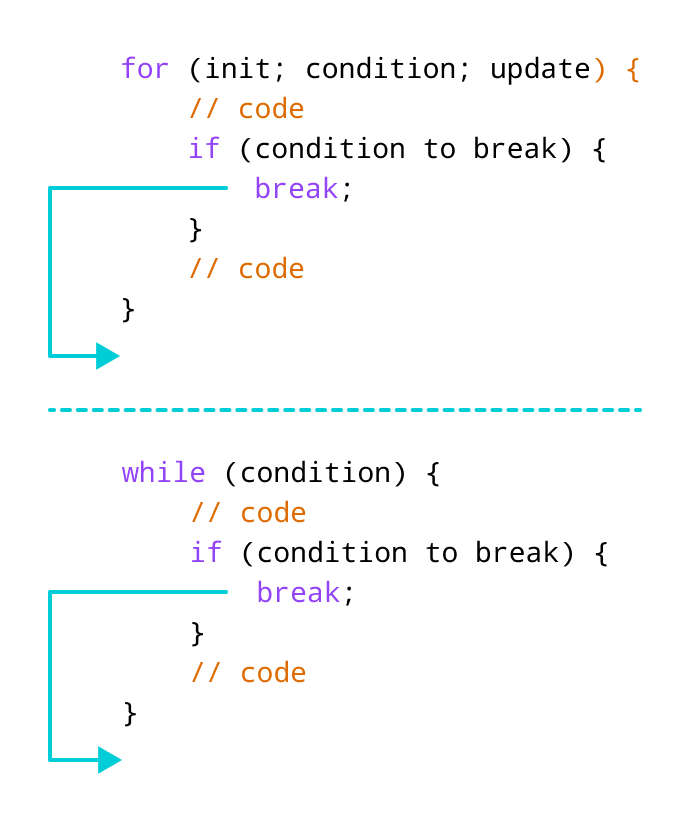(C++ programming Example for Beginners)
C++ break Statement
In this tutorial, we will learn about the break statement and its working in loops with the help of examples.
In computer programming, the break statement is used to terminate the loop in which it is used.
The syntax of the break statement is:
break;Working of C++ break Statement

Example 1: break with for loop
// program to print the value of i
#include <iostream>
using namespace std;
int main(){
for (int i = 1; i <= 5; i++) {
// break condition
if (i == 3) {
break;
}
cout << i << endl;
}
return 0;
}Output
1 2
In the above program, the for loop is used to print the value of i in each iteration. Here, notice the code:
if (i == 3) {
break;
}This means, when i is equal to 3, the break statement terminates the loop. Hence, the output doesn’t include values greater than or equal to 3.
Note: The break statement is usually used with decision-making statements.
Example 2: break with while loop
// program to find the sum of positive numbers
// if the user enters a negative numbers, break ends the loop
// the negative number entered is not added to sum
#include <iostream>
using namespace std;
int main(){
int number;
int sum = 0;
while (true) {
// take input from the user
cout << "Enter a number: ";
cin >> number;
// break condition
if (number < 0) {
break;
}
// add all positive numbers
sum += number;
}
// display the sum
cout << "The sum is " << sum << endl;
return 0;
}Output
Enter a number: 1 Enter a number: 2 Enter a number: 3 Enter a number: -5 The sum is 6.
In the above program, the user enters a number. The while loop is used to print the total sum of numbers entered by the user. Here, notice the code,
if(number < 0) {
break;
}This means, when the user enters a negative number, the break statement terminates the loop and codes outside the loop are executed.
The while loop continues until the user enters a negative number.
break with Nested loop
When break is used with nested loops, break terminates the inner loop. For example,
// using break statement inside
// nested for loop
#include <iostream>
using namespace std;
int main(){
int number;
int sum = 0;
// nested for loops
// first loop
for (int i = 1; i <= 3; i++) {
// second loop
for (int j = 1; j <= 3; j++) {
if (i == 2) {
break;
}
cout << "i = " << i << ", j = " << j << endl;
}
}
return 0;
}Output
i = 1, j = 1 i = 1, j = 2 i = 1, j = 3 i = 3, j = 1 i = 3, j = 2 i = 3, j = 3
In the above program, the break statement is executed when i == 2. It terminates the inner loop, and the control flow of the program moves to the outer loop.
Hence, the value of i = 2 is never displayed in the output.
C++ for Beginners: C++ break Statement
Disclaimer: The information and code presented within this recipe/tutorial is only for educational and coaching purposes for beginners and developers. Anyone can practice and apply the recipe/tutorial presented here, but the reader is taking full responsibility for his/her actions. The author (content curator) of this recipe (code / program) has made every effort to ensure the accuracy of the information was correct at time of publication. The author (content curator) does not assume and hereby disclaims any liability to any party for any loss, damage, or disruption caused by errors or omissions, whether such errors or omissions result from accident, negligence, or any other cause. The information presented here could also be found in public knowledge domains.
